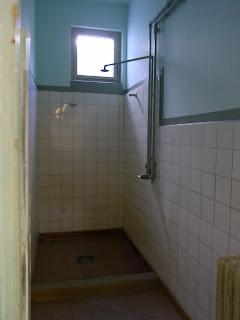

 Last week I had the opportunity to tour the Dresden Stasi Museum and receive an English guided tour, this was the main office for this area. The Eastern part of Germany has been through many, many changes, for example, Dresden was horribly bombed during WWII and after that came the separation of East & West Germany, creating the DDR (Deutsche Demokratiksche Republic) and control by the Russians. The Stasi, or secret police was created to keep people in line and discourage any type of rebellion against the government. Since we arrived here I read an interesting book called, Stasiland, and it really sheds some light on what it was like to live here during that time and how difficult it was.
Last week I had the opportunity to tour the Dresden Stasi Museum and receive an English guided tour, this was the main office for this area. The Eastern part of Germany has been through many, many changes, for example, Dresden was horribly bombed during WWII and after that came the separation of East & West Germany, creating the DDR (Deutsche Demokratiksche Republic) and control by the Russians. The Stasi, or secret police was created to keep people in line and discourage any type of rebellion against the government. Since we arrived here I read an interesting book called, Stasiland, and it really sheds some light on what it was like to live here during that time and how difficult it was. The first part of our tour was the very lower, basement level, this area was mostly part of the Russian controlled cells, the Stasi section came much later. It was dreadfully cold and damp, and was very unpleasant. We were fortunate because we had on warm clothing and were only below for a short time. When individuals were arrested they basically had the clothing on their back and nothing more. If you were arrested in winter maybe you were lucky because you still had on your coat, others were not so fortunate. There were approximately 150 prisoners there at one time and it was a very small area, so it was crowded.
As we went upstairs we learned that the Stasi really prided themselves on messing with people's minds. That was their best method of torture. Lack of sleep was constant and they used this a lot to get people to confess to things they'd never done, the prisoners were only allowed to sleep on their backs with their heads turned to one side and their arms laying on top of the blankets. The wardens would continuously disrupt them all night long if they didn't keep this position. Most likely the most frustrating and horrible part of this situation is that there were so many spy's that NO one could be trusted for fear you would be reported or arrested. So many false accusations were made and people arrested for virtually nothing, they didn't even know what they were supposed to confess to.

Family members, neighbors & co-workers could all be spies, it is difficult to think that anyone living here during that time could have had any joy, or trust. One story was about a small group of women that would get together and discuss politics over tea. The Stasi found out that one of the women suffered from depression, so they would sneak into her house and move stuff around, take things for days and return them later, switch things out of her mail, hide things, all done to make her think she was totally losing her mind, which she wasn't, they just really messed her up-incidentally, she quit the group and didn't feel up to talking politics anymore. That is exactly what they wanted.

These photos show the Solitary Confinement Room, people were left in there for days, totally in the dark with just one small stool. Also shown, is the horrible showering conditions, the warden would always be there and sometimes after 2 minutes, the warden would cut off the water and the poor prisoner wouldn't be allowed to rinse off the soap. Most cells held 2 people but some had 3, you couldn't even talk to your cellmate because they could potentially be a spy. Also shown, is the Interogation Room, here you would be brought to make your confession, often you would have to wait forever and frequently start to doze off, (which is what they wanted) at that point the warden would say thanks for confessing and your trial be requested. People would be so disoriented and sleep deprived they wouldn't recall what they had had happened. Trials were done in groups and you had the chance to meet with your lawyer the day before, although the lawyer was just there to tell you (already) how long your sentence was going to be. What I find so fascinating is that these things were still going on up until 1990. People would cross the street to the other side so they wouldn't have to walk in front of the building.



Even more interesting is learning about the adjustments that have happened and still need to happen between East & West Germany. Although there is no longer a physical wall many Germans feel like there is still a huge separation between the two sides. Our guide explained that his dream is for the future generations to not know, feel, see or learn of a separation, that Germany is truly one land without any dividers. After reading the Stasiland book and seeing this place first hand, it really makes you stop and think.

No comments:
Post a Comment